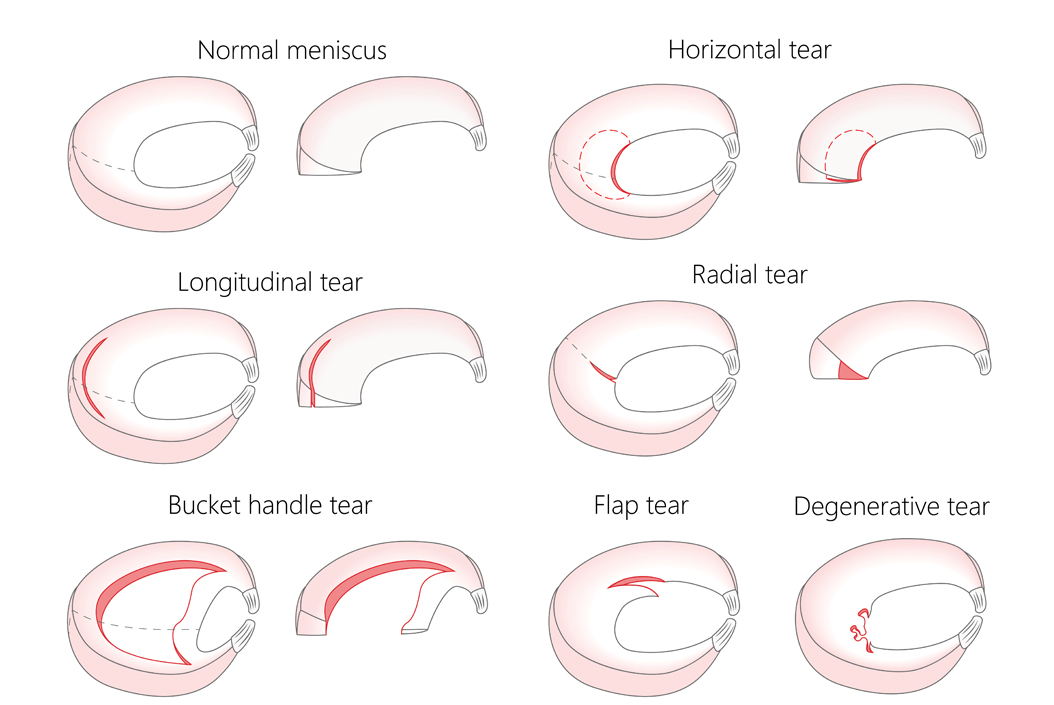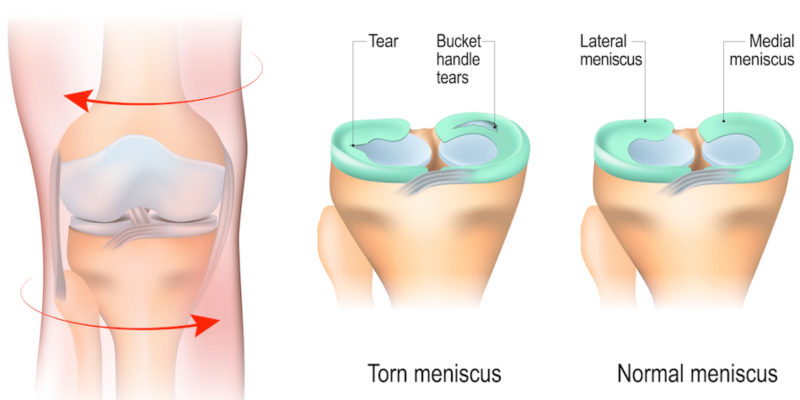Your knee meniscus is fibrocartilage that separates thigh bone (femur) from your shin bone (tibia). It is commonly referred to as your “cartilage”. Each knee joint has a medial meniscus and a lateral meniscus. Your knee meniscus has unique shapes. They are a wedged, kidney shape.
Your meniscus act like a wedge to assist with the rotational stability created by the anterior cruciate ligament. The meniscus also acts as a shock absorber. As we walk, run, and jump the knee absorbs tremendous forces. Your meniscus helps to absorb these forces so that the bone surfaces are not damaged.
The amount of force increases exponentially as the speed of movement increases from walking to running to jumping. Your meniscus helps to disperse the compressive forces over the entire knee rather than isolating them.
What is a Meniscus Tear?
Meniscus tears are among the most common knee injuries. Athletes, particularly those who play contact sports, are at risk for meniscus tears. However, anyone at any age can tear a meniscus.
The traumatic type of meniscal injuries is most often sports-related. The meniscus can be torn anterior to posterior, radially (parrot beak), or can have a bucket handle appearance. In the older adult, the tear may be due to a natural age-related degeneration of the meniscus or a rough arthritic femoral bone surface tearing into the softer meniscus.
Depending on the type of meniscus tear, meniscus repair may be complicated. A large meniscus tear that is inadequately treated may cause premature degenerative bony (arthritis) changes.

Signs
The history of a painful twist occurring on a slightly flexed knee will indicate the likelihood of a meniscus tear. You may also experience clicking, popping, or locking of the knee. These symptoms are usually accompanied by pain along the knee joint line and joint swelling.
The clinical examination may reveal tenderness along the knee joint line. You will usually notice it is painful to squat.
You might feel a “pop” when you tear a meniscus. Most people can still walk on their injured knee. Many athletes keep playing with a tear. Over 2 to 3 days, your knee will gradually become more stiff and swollen.
The most common symptoms
Pain in the knee
Stiffness and swelling
Catching or locking of your knee
The sensation of your knee “giving way”
You are not able to move your knee through its full range of motion (knee get stuck or locked up)
Physical Examination and Patient History
After discussing your symptoms and medical history, your therapist will examine your knee. We check for tenderness along the joint line where the meniscus sits. This often signals a tear.
The tests for meniscus tears will be performing and puts tension on a torn meniscus. If you have a meniscus tear, the combination of a few tests will be positive. In addition, your mechanism of injury and your daily activity, history of injury and your sign and symptoms will be as important as the physical examination test.
Ultrasound Imaging or MRI?
An MRI scan is the most accurate non-invasive test to confirm a meniscus tear in comparison to an Ultrasound scan. In addition, X-rays do not show a meniscus tear. However, not everyone needs an MRI scan after a meniscus tear. After your initial consultation with your physical therapist, you may be sent for an MRI for further investigation.
Treatment for Meniscus Tear
Treatment for meniscal tears depends on the size and location of the tear. Other factors which influence treatment include age, activity level, and related injuries. The outer portion of the meniscus often referred to as the “red zone,” and it has a good blood supply and can sometimes heal on its own if the tear is small. In contrast, the inner two-thirds of the meniscus, known as the “white zone,” does not have a good blood supply. Tears in this region will not heal on their own as this area lacks blood vessels to bring in healing nutrients.
Conservative Management
Conservative management is useful for the initial treatment for acute knee trauma and as a first-line treatment method in meniscal tears. In the former situation, the ‘POLICE’ (Protection, Optimal Loading, Rest, Ice, Compression, Elevation) protocol is applied. The conservative management consists of anti-inflammatory and analgesic medications, quadriceps strengthening, activity modification, unloader bracing and intra-articular injections, would be advised depends on the individual.
FOLLOW US ON YOUTUBE AND GET ACCESS TO OUR WEEKLY FREE REHABILITATION EXERCISES.
Our Approach
Dublin Sports Injury Clinic is a physical therapy clinic based in Pearse Street, Dublin 2. We have a holistic approach to our assessment and treatment. The initial assessment helps us to explore the cause of your injury and help you to get pain free shortly and stop any further injuries. We will design a customized training program for you to start with, and we will coach you and monitor your progress closely. We will prescribe relative rest or modified activities as required. Depending on the individual requirement, we apply manual therapy accompanied by stretching to restore tissue elasticity and reduce the strain in the muscle-tendon unit with joint motion.
Next step
Want to get in touch with our team of a therapist or you are looking for some advice? Simply fill in your details below & we get in touch with you shortly.
Disclaimer: This article is for information only and should not be used for the diagnosis or treatment of medical conditions. You can contact us if you would like to book an appointment or get some advice from our therapist.

